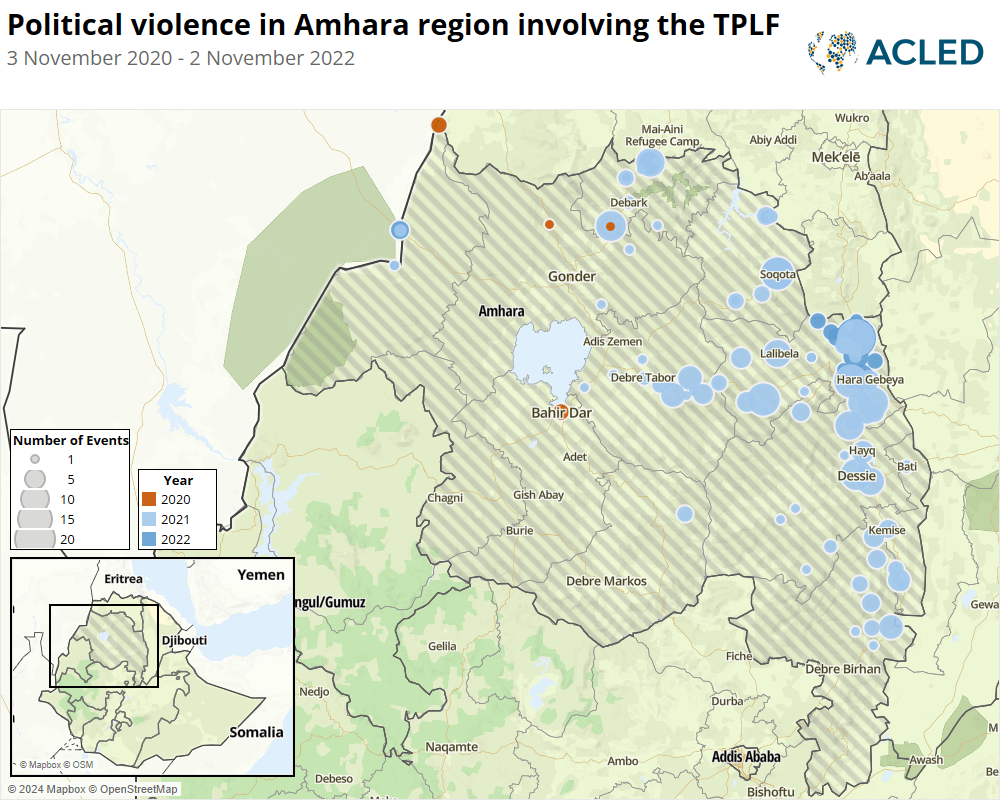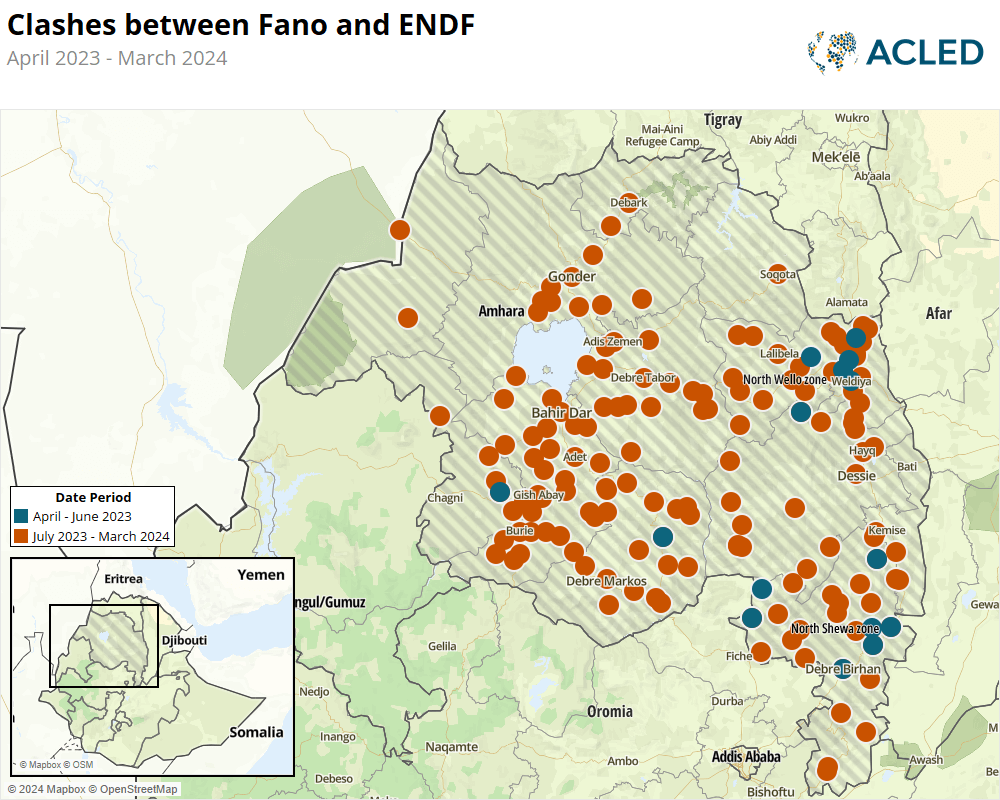Last updated: 08/08/2024
Amhara region is located in northern Ethiopia. It is bordered by Tigray region to the north, Afar to the east, Benshangul/Gumuz to southwest, Oromia to the south, and Sudan to the west. It is estimated that the region’s population is around 22.5 million.1UNICEF, ‘Amhara: Regional brief,’ April 2022 The majority in this region are ethnic Amharas. Qemant, Agew (Awi), Oromo, and other ethnic groups also reside in the region. There are nine zones —Wag Hamra, North Wello, North Gondar, South Gondar, South Wello, North Shewa, East Gojam, West Gojam, and Awi — and two special zones, Bahir Dar and Oromia Special zones, in the region. The capital city of the region is Bahir Dar.
The Amhara region bore the brunt of some of the most intense fighting periods as a theater of the northern Ethiopia conflict in 2021 and 2022. During clashes in the summer and fall of 2021, damages due to the conflict reportedly reached into the hundred million dollar range, with thousands of civilians and combatants from the region killed.2Alemnew Mekonen, Tamirat Dinasa and Eshete Bekele, ‘The war cost the Amhara Credit and Savings Institute more than 6 billion birr; The institution,’ Deutsche Welle Amharic, 21 October 2021; Amhara Media Corporation, ‘The outcome of the study on the damage caused in the Amhara region due to the invasion of the terrorist TPLF group have been announced,’ 29 September 2022 The most heavily affected areas of the region include the communities in North and South Wello zones along the A2 Highway, which were attacked by the Tigray People’s Liberation Front (TPLF) forces — Tigray Defense Forces — in the summer of 2021 (see map below). The northern parts of the Gondar zone bordering the Tigray region sustained fighting throughout the conflict. Towns and rural areas in Wag Hamra zone suffered greatly during the war, with aid unable to reach certain woredas for over a year. 3Addis Standard, ‘News: Wag Hemra Zone receives first aid convoy in more than a year,’ 27 July 2022

Conflict with the TPLF and the perceived inadequacy of the federal government to protect civilians or stop the TPLF advance exacerbated existing fissures between political factions in Amhara over the future of ethno-nationalism in the region. As TPLF forces advanced through the region in October 2021, the National Movement of Amhara (NaMA) accused the government of inadequacy and “failing to capitalize on its military advantage over the [TPLF]”4National Movement of the Amhara, ‘National Movement of the Amhara’s urgent public call to guarantee existence,’ 17 October 2021 (for more details on this period, see the EPO Monthly: October 2021). Following the retreat of TPLF forces from Amhara region, crackdowns on ethno-nationalist elements by the federal government, including the arrest of Fano militias and members of NaMA, resulted in sporadic violence in the spring of 2022 (for more, see the EPO Monthly: April-May 2022).
In April 2023, the government’s decision to integrate all regional special forces into various security sectors sparked demonstrations and battles in Amhara region. At least 15 fatalities were recorded in the context of these demonstrations, most as a result of the Ethiopian National Defense Forces (ENDF) firing on protesters in an attempt to disperse them. However, after a week of instability in the region, violence subsided around 13 April 2023 (for more, see the EPO Monthly: April 2023). The situation intensified yet again on 27 April, when unidentified gunmen ambushed and killed the head of the Amhara Prosperity Party and a member of the party’s executive committee along with his security detail and other members of the local administration around Menze Guwaza area in North Shewa zone as they were traveling from Mehal Meda to Debre Birhan.
Areas in Amhara region inhabited by ethnic minorities have also rebelled against rising Amhara nationalism. Violence stemming from deep-rooted conflict frequently occurs in, and in the areas surrounding, the Oromia special and North Shewa zones in Amhara region, where Oromo ethno-nationalists often clash with Amhara regional forces (for more, see the EPO’s Oromia special zone and North Shewa zone conflict profile). ACLED has also recorded a series of clashes between regional troops and Agew-Qemant ethnic militias in 2018.
Fano insurgency
‘Fano’ refers to a group of armed youth, generally from Amhara region, who are involved in community protection. The term took on new connotations in the later years of the Ethiopian People’s Revolutionary Democratic Front (EPRDF) when it became synonymous with an anti-government youth movement that led to massive nonviolent protests and a limited violent insurgency in Amhara region. Fano militias fought alongside the Ethiopian federal government and Amhara regional special forces against the TPLF during the northern Ethiopia conflict. Tension between Fano militias and the government turned violent in April 2023 — following the government’s decision to dissolve regional special forces — and escalated since August 2023. In April 2023, the conflict between Fano and government forces was mostly concentrated in North Wello and North Shewa zones. In August 2023, it began to spread across the region, including to the regional capital city, Bahir Dar (see map below).

There are two root causes for this conflict. The first is linked to political deadlocks on the status of the disputed territories in Southern and Western Tigray zones, which are officially under Tigray region but contain ethnic Amhara residents who wish to be governed by Amhara region. The second issue is the overall state of security for the Amhara people, as many Amhara ethnic civilians have been the target of violent attacks throughout the country. The government’s decision to dissolve the country’s regional special forces was viewed by Fano, and many in Amhara region, as increasing the risk that the Amhara people will continue to be defenseless against the aggression of forces from other regions (for more on this conflict, see the EPO’s Amhara Conflict: Fano Insurgency page).
Security structures in Amhara region
Prior to April 2023, Amhara regional special forces and local militias were regularly engaged in violent conflict outside Amhara region, though they were regional forces. In addition to their activity in Western and Southern Tigray zones, Amhara special forces and Fano and Amhara ethnic militias were engaged in fighting with the Sudanese Armed Forces along the border in an area known as al-Fashaga. After Sudanese forces displaced Amhara farmers from the contested area in November 2020, Amhara local militias and special forces responded, attacking the Sudanese forces and driving an intense border conflict (for more information, see this ACLED report; also see the EPO’s Al Fashaga Border Dispute profile).
The unrest and conflict in Amhara region since April 2023 have created governance and security vacuums in various locations of the region, as local officials and security forces were killed either by Fano militias or unidentified armed men.5Ethiopia Human Rights Commission, ‘The human rights impact of the armed conflict on civilians in Amhara Regional State,’ 14 August 2023; Addis Maleda, ‘Reportedly government officials of Shewa Robit town fled to Debre Berhan and Addis Ababa,’ 18 July 2023 This forced many local and security officials to flee from their homes, leaving their towns under the control of Fano militias following the outset of the conflict in August 2023. On 3 August 2023, the Amhara regional government requested assistance from the federal government as insecurity in the region had gone beyond the control of the regional security forces.6Addis Maleda, ‘The Amhara government requested the federal government to implement the necessary legal framework to control the lack of security in the Amhara region,’ 3 August 2023 As a result, the federal government declared a state of emergency on 4 August 2023.7Office of the Prime Minister-Ethiopia, ‘Decisions of the 23rd regular meeting of the Council of Ministers,’ 4 August 2023; Federal Democratic Republic of Ethiopia Government Communication Service, ‘State of Emergency Proclamation 6/2015,’ 4 August 2023; Addis Maleda, ‘The Amhara government requested the federal government to implement the necessary legal framework to control the lack of security in the Amhara region,’ 3 August 2023 The regional government also began to reorganize the regional security sectors — kebele militias and state police — in August to close the security gap in the region.8Amhara Media Corporation, ‘Amhara national government gave appointments to security officials,’ 1 September 2023

